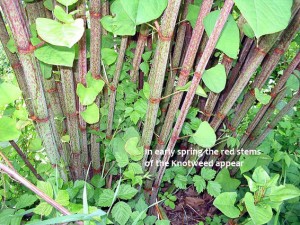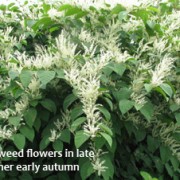We need to talk about Knotweed.
We recently went to visit a property near Highgate. The client had just purchased it – at what appeared to be a very good price. They had bought the house as a renovation project and had asked us to design and build a garden for them. Unfortunately, it was during the site visit that we discovered Japanese Knotweed.
This is not only a homeowner’s worst nightmare but it becomes even more problematic when the offending plant has originated from the garden next door. Unfortunately, as a responsible garden design and build company we will not be able to carry out any landscaping that entails the removal of Knotweed contaminated soil.
We can however, design you a beautiful space in readiness for when your garden is declared Knotweed free.
Japanese Knotweed – a brief history
Japanese knotweed (Fallopia japonica) as the name suggests originates from Japan. It was brought to the UK by the enthusiastic plant finders of the Victorian era. They naively brought it back to the UK to plant in their gardens based purely on its cosmetic appeal. They had little understanding of just how much of a nuisance this innocent looking plant would become in the forthcoming centuries.

It has been purported that there is not a six-mile square area that is Knotweed free.
It has been described by the RHS as a thug.
https://www.rhs.org.uk/advice/
The plant is so tough and determined that it finds no problem ripping up tarmac and penetrating flooring in houses.
In its native countries such as, Japan, China, Taiwan and Korea the plant is kept under control in a natural eco-system by its many pests and diseases but in the United Kingdom and other parts of the world there are no predators and the plant is free to roam without being impeded.
How do I get rid of Japanese Knotweed from my garden? Can I get rid of it myself?
The plant spreads indefinitely on one root system. What this means is that it sends out runners underground that spring up all over the garden. It is so tough and resilient that it can withstand being hacked at with an axe, being set fire to and being doused in herbicide. It is so invasive that it can grow 10 cm per day and it only takes a slither of the plant stuck to the bottom of a boot to be inadvertently introduced to a new area.
It is such a problem that the Environmental Agency has put a control order on this plant.
It is not illegal to have Knotweed on your land or in your garden but it is a criminal offence to allow it to grow onto other people’s property and you could be prosecuted for causing a private nuisance.
Japanese knotweed is classified as a harmful and invasive weed.
Yes, in theory, you can treat the Knotweed yourself and there are a few ways to approach this. Non-biological controls of digging out can be employed but this is a laborious task. The roots of Knotweed can penetrate to depths of at least two metres and making sure you remove all the pieces is almost impossible.
If you leave even the slightest sliver then the plant will grow back. This method also creates a problem with regard to disposal. Knotweed is classified as a controlled waste. This means that you have to use a specialist contractor who is licensed to remove and transport hazardous waste to an authorized landfill site.
It is important to bear in mind that wrongful disposal of Knotweed not only incurs hefty fines but could also see you facing up to 2 years in prison.
For further information check out: https://www.gov.uk/guidance/
I have heard that having Knotweed in your garden puts mortgage providers off lending money. Is this really true?
Yes, unfortunately this is the case but not all is doom and gloom.
Now that mortgage lenders are more educated on the subject the panic has subdued a little. However, if they are going to lend to you they will require a plan of action and detailed assurances that you will be employing a specialist contractor to eradicate the problem. They are aware that the removal of Knotweed takes at least 3 years.
Also be aware that if a valuer carrying out a valuation on behalf of a mortgage lender discovers Knotweed in your garden, then they are obliged to include this in the report.
Finding Knotweed in yours or in a neighbour’s garden can have a substantial effect on the price of your property. Some lenders will automatically refuse to lend money on the discovery of Knotweed. Others will lend but will want to see a treatment plan or management plan in place. They will also request to see an insurance-backed guarantee.
Let’s end on a positive note.
Scientific researchers have spent the past 5 years carefully studying Knotweed’s many pests and diseases and have narrowed it down to the pest Alphalara itadori.
Researchers for CABI, (a not for profit international research body specializing in agriculture and the environment) announced that Alphalara itadori successfully survived through the British winter. They have been studying the insect very closely at its test sites across the UK. They are extremely hopeful that it will be available for general release as a natural biological control for this nuisance plant.


